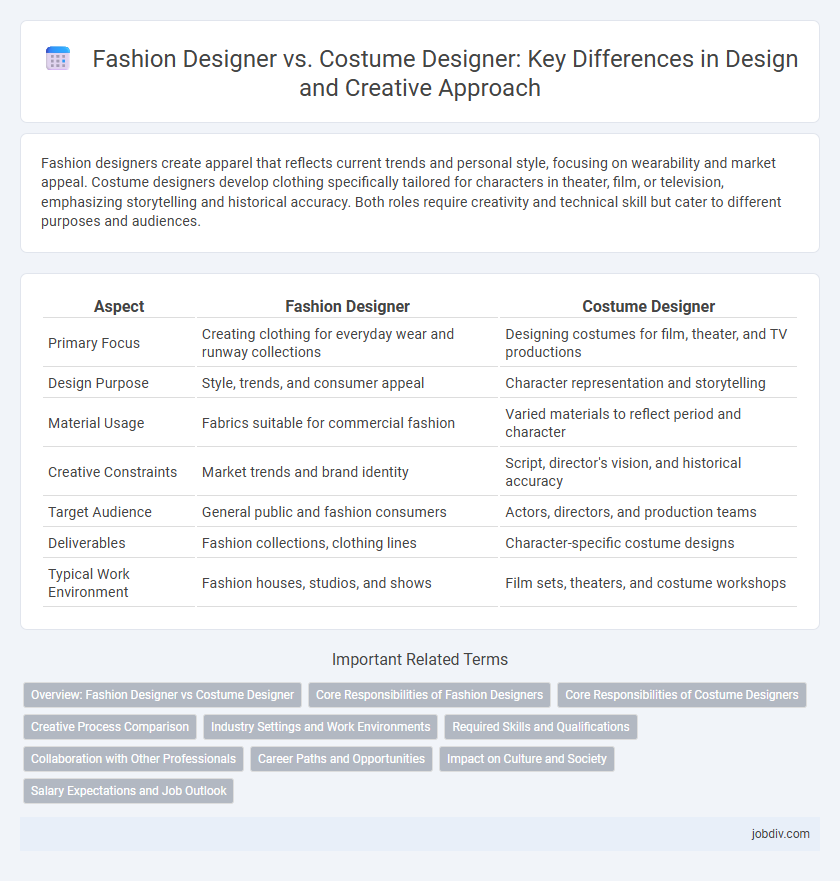Fashion designers create apparel that reflects current trends and personal style, focusing on wearability and market appeal. Costume designers develop clothing specifically tailored for characters in theater, film, or television, emphasizing storytelling and historical accuracy. Both roles require creativity and technical skill but cater to different purposes and audiences.
Table of Comparison
| Aspect | Fashion Designer | Costume Designer |
|---|---|---|
| Primary Focus | Creating clothing for everyday wear and runway collections | Designing costumes for film, theater, and TV productions |
| Design Purpose | Style, trends, and consumer appeal | Character representation and storytelling |
| Material Usage | Fabrics suitable for commercial fashion | Varied materials to reflect period and character |
| Creative Constraints | Market trends and brand identity | Script, director's vision, and historical accuracy |
| Target Audience | General public and fashion consumers | Actors, directors, and production teams |
| Deliverables | Fashion collections, clothing lines | Character-specific costume designs |
| Typical Work Environment | Fashion houses, studios, and shows | Film sets, theaters, and costume workshops |
Overview: Fashion Designer vs Costume Designer
Fashion designers create original clothing and accessory concepts, focusing on trends, fabrics, and wearability for everyday use and commercial markets. Costume designers conceptualize and produce outfits specifically tailored to characters and narratives within film, theater, or television, emphasizing historical accuracy and storytelling. Both roles require creative skills and knowledge of textile properties but serve distinct purposes in design and production.
Core Responsibilities of Fashion Designers
Fashion designers primarily focus on creating original clothing and accessory designs that align with current trends and consumer preferences, emphasizing innovation and market appeal. They conduct extensive research on fabrics, colors, and styles to develop seasonal collections that reflect brand identity and target demographics. Their core responsibilities include sketching designs, selecting materials, overseeing production, and collaborating with manufacturers to ensure quality and timely delivery.
Core Responsibilities of Costume Designers
Costume designers specialize in creating clothing that reflects characters' personalities, time periods, and settings within film, theater, or television productions. They conduct thorough research on historical styles, fabric types, and cultural elements to ensure authenticity and coherence with the narrative. Their core responsibilities include sketching designs, selecting textiles, coordinating fittings, and collaborating closely with directors and actors to enhance storytelling through wardrobe.
Creative Process Comparison
Fashion designers concentrate on creating wearable, trend-driven apparel that balances aesthetics with functionality, prioritizing market appeal and brand identity. Costume designers focus on character development and storytelling, using fabric, texture, and color to enhance narrative authenticity for theater, film, or television productions. Both roles require extensive research and collaboration, but fashion design emphasizes innovation within seasonal collections, while costume design demands historical accuracy and thematic consistency.
Industry Settings and Work Environments
Fashion designers primarily work in retail, apparel companies, and fashion houses, focusing on creating everyday clothing lines that cater to consumer trends and mass markets. Costume designers operate mostly within film, theater, and television industries, crafting garments that reflect character, period, and story, often collaborating closely with directors and production teams. The work environment for fashion designers is typically fast-paced and trend-driven, while costume designers engage in more research-intensive settings that require historical accuracy and narrative cohesion.
Required Skills and Qualifications
Fashion designers require strong skills in creative design, textile knowledge, and trend forecasting, often holding degrees in fashion design or apparel production. Costume designers need expertise in historical research, fabric selection, and garment construction, usually backed by education in theater arts or costume design. Both roles demand proficiency in sketching, sewing, and collaboration with clients or production teams.
Collaboration with Other Professionals
Fashion designers collaborate closely with textile manufacturers, marketing teams, and retail buyers to create commercially viable clothing lines that align with current market trends. Costume designers work in tandem with directors, actors, and production designers to develop character-specific attire that supports storytelling in film, theater, and television. Both roles require effective communication and adaptability to integrate creative vision with practical constraints.
Career Paths and Opportunities
Fashion designers focus on creating original clothing and accessory lines for retail and runway markets, with career opportunities in fashion houses, brands, and private labels. Costume designers specialize in designing attire for film, theater, and television productions, collaborating closely with directors to develop character-specific looks. Both career paths require strong creativity and technical skills, but fashion designers navigate the commercial industry, while costume designers are integral to storytelling in performing arts.
Impact on Culture and Society
Fashion designers shape contemporary culture by creating trends that influence everyday style, reflecting societal values and economic shifts through wearable art. Costume designers impact culture by preserving and interpreting historical periods and narratives on stage and screen, deepening public understanding of identity and heritage. Both professions drive societal expression, with fashion designers shaping modern identity and costume designers connecting audiences to cultural history.
Salary Expectations and Job Outlook
Fashion designers typically earn an average salary ranging from $70,000 to $110,000 annually, reflecting higher demand in retail and commercial markets, while costume designers average between $45,000 and $75,000, with opportunities concentrated in film, theater, and television industries. The job outlook for fashion designers projects a steady growth rate of 5% over the next decade, driven by global apparel market expansion, whereas costume designers face slower growth at approximately 2%, influenced by fluctuating entertainment production budgets. Salary expectations vary significantly based on experience, portfolio strength, and industry connections, with luxury fashion brands and major studios offering the highest compensation.
Fashion Designer vs Costume Designer Infographic

 jobdiv.com
jobdiv.com